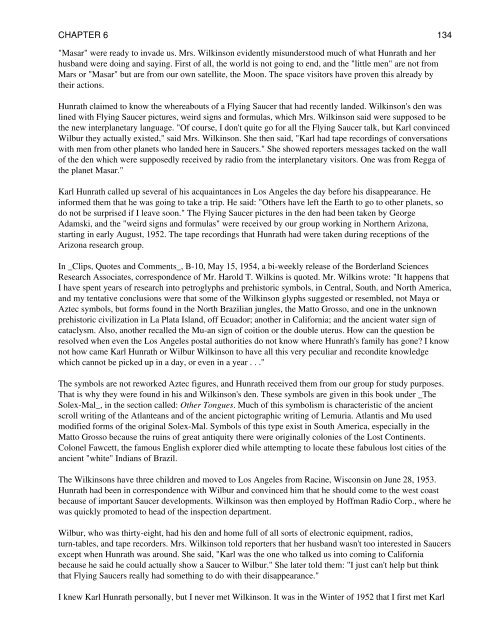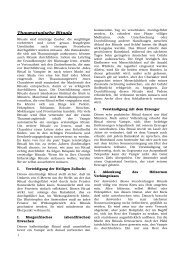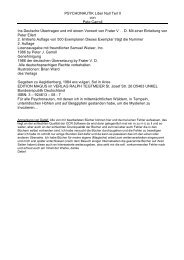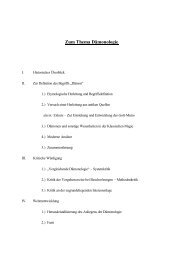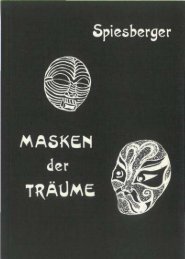CHAPTER 2 CHAPTER 3 CHAPTER 1 CHAPTER 2 CHAPTER 3 ...
CHAPTER 2 CHAPTER 3 CHAPTER 1 CHAPTER 2 CHAPTER 3 ...
CHAPTER 2 CHAPTER 3 CHAPTER 1 CHAPTER 2 CHAPTER 3 ...
You also want an ePaper? Increase the reach of your titles
YUMPU automatically turns print PDFs into web optimized ePapers that Google loves.
<strong>CHAPTER</strong> 6 134<br />
"Masar" were ready to invade us. Mrs. Wilkinson evidently misunderstood much of what Hunrath and her<br />
husband were doing and saying. First of all, the world is not going to end, and the "little men" are not from<br />
Mars or "Masar" but are from our own satellite, the Moon. The space visitors have proven this already by<br />
their actions.<br />
Hunrath claimed to know the whereabouts of a Flying Saucer that had recently landed. Wilkinson's den was<br />
lined with Flying Saucer pictures, weird signs and formulas, which Mrs. Wilkinson said were supposed to be<br />
the new interplanetary language. "Of course, I don't quite go for all the Flying Saucer talk, but Karl convinced<br />
Wilbur they actually existed," said Mrs. Wilkinson. She then said, "Karl had tape recordings of conversations<br />
with men from other planets who landed here in Saucers." She showed reporters messages tacked on the wall<br />
of the den which were supposedly received by radio from the interplanetary visitors. One was from Regga of<br />
the planet Masar."<br />
Karl Hunrath called up several of his acquaintances in Los Angeles the day before his disappearance. He<br />
informed them that he was going to take a trip. He said: "Others have left the Earth to go to other planets, so<br />
do not be surprised if I leave soon." The Flying Saucer pictures in the den had been taken by George<br />
Adamski, and the "weird signs and formulas" were received by our group working in Northern Arizona,<br />
starting in early August, 1952. The tape recordings that Hunrath had were taken during receptions of the<br />
Arizona research group.<br />
In _Clips, Quotes and Comments_, B-10, May 15, 1954, a bi-weekly release of the Borderland Sciences<br />
Research Associates, correspondence of Mr. Harold T. Wilkins is quoted. Mr. Wilkins wrote: "It happens that<br />
I have spent years of research into petroglyphs and prehistoric symbols, in Central, South, and North America,<br />
and my tentative conclusions were that some of the Wilkinson glyphs suggested or resembled, not Maya or<br />
Aztec symbols, but forms found in the North Brazilian jungles, the Matto Grosso, and one in the unknown<br />
prehistoric civilization in La Plata Island, off Ecuador; another in California; and the ancient water sign of<br />
cataclysm. Also, another recalled the Mu-an sign of coition or the double uterus. How can the question be<br />
resolved when even the Los Angeles postal authorities do not know where Hunrath's family has gone? I know<br />
not how came Karl Hunrath or Wilbur Wilkinson to have all this very peculiar and recondite knowledge<br />
which cannot be picked up in a day, or even in a year . . ."<br />
The symbols are not reworked Aztec figures, and Hunrath received them from our group for study purposes.<br />
That is why they were found in his and Wilkinson's den. These symbols are given in this book under _The<br />
Solex-Mal_, in the section called: Other Tongues. Much of this symbolism is characteristic of the ancient<br />
scroll writing of the Atlanteans and of the ancient pictographic writing of Lemuria. Atlantis and Mu used<br />
modified forms of the original Solex-Mal. Symbols of this type exist in South America, especially in the<br />
Matto Grosso because the ruins of great antiquity there were originally colonies of the Lost Continents.<br />
Colonel Fawcett, the famous English explorer died while attempting to locate these fabulous lost cities of the<br />
ancient "white" Indians of Brazil.<br />
The Wilkinsons have three children and moved to Los Angeles from Racine, Wisconsin on June 28, 1953.<br />
Hunrath had been in correspondence with Wilbur and convinced him that he should come to the west coast<br />
because of important Saucer developments. Wilkinson was then employed by Hoffman Radio Corp., where he<br />
was quickly promoted to head of the inspection department.<br />
Wilbur, who was thirty-eight, had his den and home full of all sorts of electronic equipment, radios,<br />
turn-tables, and tape recorders. Mrs. Wilkinson told reporters that her husband wasn't too interested in Saucers<br />
except when Hunrath was around. She said, "Karl was the one who talked us into coming to California<br />
because he said he could actually show a Saucer to Wilbur." She later told them: "I just can't help but think<br />
that Flying Saucers really had something to do with their disappearance."<br />
I knew Karl Hunrath personally, but I never met Wilkinson. It was in the Winter of 1952 that I first met Karl


